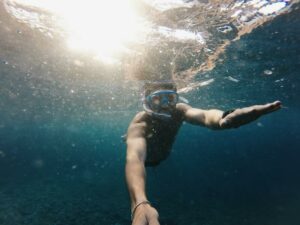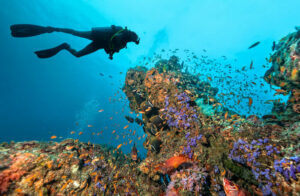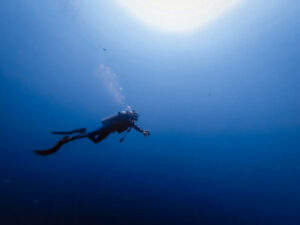Swimming wetsuits are a crucial piece of gear for open water swimmers, triathletes, and anyone diving into cold waters. Unlike traditional wetsuits, which are designed primarily for warmth in activities such as surfing and diving, swimming wetsuits offer a blend of buoyancy, flexibility, and thermal protection tailored specifically to the needs of swimmers. If you want to know more about how to buy a wetsuit for swimming, the design, benefits and maintenance of swimming wetsuits, this article will help you make an informed decision.
In this article, you will get answers to the following questions:
- Can you swim in a wetsuit?
- What are the best wetsuits for swimming in open water?
- How to choose a wetsuit for swimming?
- Why are swimming wetsuits different from other wetsuits?
Can you swim in a Wetsuit?
The short answer is: Yes, you can swim in a wetsuit. Wetsuits are commonly used in various water activities, including swimming, particularly in open water conditions such as oceans, lakes, and rivers. They provide thermal insulation, buoyancy, and protection against environmental elements, making them a popular choice for swimmers who want to stay warm and comfortable in colder water temperatures.
Benefits of Swimming in a Wetsuit
Swimming in a wetsuit offers a multitude of benefits, from enhanced buoyancy and thermal protection to reduced drag and increased safety. Whether you’re a competitive athlete or a recreational swimmer, a wetsuit can significantly improve your swimming experience by making it more comfortable, efficient, and enjoyable.
Here are the main reasons for you to invest in a swimming wetsuit:
1. Enhanced Buoyancy
Wetsuits are designed with buoyancy panels that help keep the swimmer’s body in an optimal position in the water. This reduces drag and increases efficiency, allowing for faster swimming. Increased buoyancy means less energy is spent keeping the body afloat, which can help swimmers conserve energy and reduce fatigue during long swims.
2. Thermal Protection
Wetsuits provide excellent thermal insulation by trapping a thin layer of water between the suit and the skin. The body warms this layer, which helps maintain body temperature in cold water, extending swim time and comfort. By keeping the swimmer warm, wetsuits significantly reduce the risk of hypothermia, which can be a serious concern in open water swimming or cold conditions.
3. Reduced Drag
The smooth exterior of a wetsuit reduces water resistance, allowing swimmers to glide more efficiently through the water. Some wetsuits feature hydrophobic coatings that repel water, further reducing drag and increasing speed.
4. Increased Safety
Many wetsuits come in bright colors or have reflective strips, making swimmers more visible in open water and enhancing safety. Wetsuits protect the skin from the sun’s UV rays, jellyfish stings, abrasions, and other potential irritants found in natural water bodies.
5. Muscle Support
The snug fit of a wetsuit provides compression, which can help support muscles and reduce fatigue. This can be particularly beneficial during long swims or triathlons. Compression from the wetsuit can also minimize muscle vibration, which may lead to improved performance and reduced soreness post-swim.
6. Confidence and Comfort
Knowing that the wetsuit provides buoyancy and thermal protection can boost a swimmer’s confidence, allowing them to focus more on their technique and performance. Modern wetsuits are designed to be comfortable, with features like smooth skin neoprene and anti-chafing design elements that prevent irritation during long swims.
7. Enhanced Performance
The reduced drag and improved buoyancy from wearing a wetsuit can lead to faster swim times, which is particularly beneficial in competitive swimming and triathlons. By keeping muscles warmer and reducing the effort needed to stay afloat, wetsuits help swimmers maintain their energy levels and swim for longer periods.
8. Versatility
Wetsuits allow swimmers to comfortably swim in a variety of water temperatures and conditions, from cold oceans to temperate lakes, extending the swimming season and opportunities for open water swimming. If you plan to swim in a chlorinated pool regularly, a chlorine resistant wetsuit is essential to withstand the harsh chemicals used in pools.
What makes a Swimming Wetsuit Special?
Some design features in swimming wetsuits are specifically designed for optimizing performance, comfort, and safety in the water. For example, incorporate swimming wetsuits often strategically placed buoyancy panels made from buoyant materials like neoprene. These panels help to lift the swimmer’s body in the water, improving body position and reducing drag.
Another invention are Flexibility Zones. Modern wetsuits feature panels of thinner, more flexible neoprene in areas such as the shoulders, arms, and hips. This design allows for unrestricted movement and a natural swimming stroke, enhancing agility and efficiency.
Seam placement and construction are also very critical to minimize water entry and chafing like wetsuit rashes. Flatlock seams are commonly used to provide durability and reduce irritation, while glued and blind-stitched seams create a watertight seal.
Note:
If your wetsuit doesn’t sit right, unpleasant skin irritations may occur. Those irritations are called wetsuit rashes.
Swimming wetsuits are equipped with snug seals at the neck, wrists, and ankles to prevent water from entering the suit. These seals are typically designed to be comfortable yet effective in minimizing water flushing.
Wetsuits intended for open water swimming often include reinforced panels or materials in areas prone to abrasion, such as the knees and elbows. This enhances durability and protects against wear and tear from rough surfaces. Additionally, some wetsuits feature a thermal lining or coating on the interior to provide additional warmth and insulation in colder water conditions. This helps to maintain comfortable body temperature during longer swims.
Reading Tip
If you want to know how a wetsuit keeps you warm, check out our informative wetsuit know-how guide.To enhance the comfort and safety, many wetsuits offer built-in UV protection to shield the skin from harmful ultraviolet rays, especially important for outdoor swimming in sunny conditions. Design elements like extended zippers or adjustable closures facilitate easier entry and exit of the wetsuit, ensuring a snug fit without compromising comfort or mobility.
Types of Wetsuits for Swimming
Swimming wetsuits come in various types, each designed to cater to different swimming conditions and preferences. Choosing the right type of wetsuit depends on factors such as water temperature, swimming conditions, personal preferences for mobility and coverage, and specific use cases like competition or recreational swimming. Each type offers distinct advantages tailored to different swimming needs.
Full Wetsuits
Full swimming wetsuits offer complete coverage from the neck down to the ankles, including long sleeves and full-length legs. This design minimizes exposed skin and prevents water from flushing through the suit.
If you are looking for wetsuits for swimming in open water, this style might be the best option. It keeps you warm in the chilly conditions of the oceans and protects your body from the dangers of the constant radiation with UV-rays.
Beneficially, the extended amount of material gives your body more buoyancy and a more defined shape.
Sleeveless and Shorty Wetsuits
Sleeveless wetsuits, also known as sleeveless vests or shorty wetsuits, are a type of wetsuit that typically covers the torso and thighs but does not have sleeves. They are designed to provide thermal insulation and protection primarily to the core area, while allowing greater freedom of movement in the arms.
These wetsuits are popular in warmer water conditions or for activities where arm flexibility is crucial, such as surfing or paddleboarding in moderate climates. Even though the best surfing wetsuits are not necessarily the best swimming wetsuits, you can use one wetsuit for multiple purposes.
Swimskins
Swimskins are made from hydrophobic materials that are extremely lightweight and have minimal drag in water. They are designed to fit tightly and compress the body to reduce resistance, thereby improving hydrodynamics and swimming efficiency.
Typically constructed from advanced fabrics such as polyurethane or other proprietary blends that repel water and reduce drag. Some swimskins have a hydrophobic coating that repels water and helps maintain a streamlined profile in the water.
Attention!
Swimskins are approved for use in triathlons and other competitive swimming events where wetsuits are not permitted due to water temperature regulations.
Dry Suits for Swimming
Drysuits for swimming are typically made from waterproof materials such as breathable laminates or coated fabrics like Gore-Tex. Unlike wetsuits, they do not rely on neoprene for insulation, but rather on layers of air trapped between the suit and the body for warmth.
Special features of a dry suit for swimming include:
- Waterproof Construction: Completely seals out water to keep the wearer dry even when fully submerged.
- Material: Utilizes waterproof and breathable fabrics to allow moisture vapour to escape while preventing water from entering.
- Seals: Includes tight seals at the neck, wrists, and ankles to prevent water ingress.
- Zip: Often equipped with a waterproof zip or a dry zip that keeps water out.
- Undergarments: Worn with thermal undergarments for additional warmth, especially in cold water conditions.
Ideally, dry suits are used from swimmers in cold water environments where protection against hypothermia is essential. Nevertheless, dry suits do come with a handful of considerations.
- Dry suits do not provide buoyancy like wetsuits, which may affect swimming performance.
- While designed for swimming, dry suits may restrict some range of motion compared to wetsuits.
- Dry Suits require proper care and storage to maintain waterproof integrity and longevity of the materials.
Pool-Specific Wetsuits
Chlorine-resistant wetsuits are specialized swimwear designed to withstand the harsh chemicals found in public pools. These wetsuits are typically made from materials that are more durable and can endure prolonged exposure to chlorine without deteriorating.
They are often constructed from chlorine-resistant fabrics such as polyester blends or specific types of neoprene that have been treated to resist chlorine damage. Chlorine-resistant wetsuits are more durable and less prone to fading, stretching, or losing elasticity compared to standard wetsuits.
But not only your wetsuit needs special protection, because so does your body too.
That is why pool-specific wetsuits are ideal for swimmers who frequent chlorinated pools for training, fitness, or competition, where your skin gets damaged by the chemicals.
How to Choose a Wetsuit for Swimming
Choosing a wetsuit for swimming involves considering several key factors to ensure it meets your needs for comfort, performance, and safety. Here’s a guide to help you choose the best wetsuit for cold water swimming.
1. Type of Swimming
Determine the type of swimming you’ll be doing. For open water swimming in colder conditions, or if you are planning on getting your scuba certificate, a full-length wetsuit with thicker neoprene (typically 3-5mm) provides insulation and warmth. For warmer water or competitive swimming, consider sleeveless or shorty wetsuits with thinner neoprene for greater flexibility and less insulation.
Open Water Swimming:
- Full-Length Wetsuit: Ideal for colder water temperatures (below 15°C / 59°F). Offers full-body coverage with thicker neoprene (3-5mm) for insulation and warmth.
- Shorty Wetsuit: Suitable for moderate water temperatures (15-20°C / 59-68°F). Provides coverage from the torso to thighs with thinner neoprene (2-3mm) for flexibility and some insulation.
Triathlon:
- Sleeveless Wetsuit: Commonly used for triathlons where freedom of movement and heat dissipation are prioritized. Provides buoyancy and flexibility without restricting arm movement.
- Full-Length Wetsuit: Depending on water temperature, a full-length wetsuit may also be suitable for triathlons in colder conditions to maintain body temperature.
Pool Swimming:
- Swimskins: Designed for competitive swimming in pools. Typically made from hydrophobic materials to reduce drag and improve glide through the water.
- Chlorine-Resistant Wetsuits: Specifically designed to withstand exposure to chlorine in pools, offering durability and maintaining performance over time.
Surf Swimming:
- Surf-specific Wetsuits: These wetsuits are designed with features like reinforced seams, knee pads, and abrasion-resistant materials to withstand the rigors of surfing and wave riding.
Recreational Swimming:
- Shorty Wetsuits: Suitable for casual swims in moderately cool water. Provides some insulation while allowing freedom of movement.
- Full-Length Wetsuits: Depending on water temperature, a full-length wetsuit can also be used for recreational swimming to stay comfortable in cooler conditions.
2. Fit
A wetsuit should fit snugly, but not restrict movement or cause discomfort. It should conform closely to your body without sagging or bunching, especially around the shoulders, chest, and legs. A proper fit prevents water from flushing in and out, maintaining warmth.
If you are not sure whether you know your right wetsuit size or not, you can consult our comprehensive wetsuit buying guide and figure out exactly where and what to measure. Believe me, nothing takes the fun away faster than a restricting, badly fitted wetsuit!
3. Thickness
Since wearing undergarments is not a good option for water sports athletes, the only option to adapt to colder conditions, is by investing in a thicker wetsuit to withstand the icy waves or the cooler streams of the ocean’s depths.
Choose the appropriate neoprene thickness based on water temperature:
- Cold water (below 15°C / 59°F): 3-5mm thickness for full-length wetsuits.
- Moderate water (15-20°C / 59-68°F): 2-3mm thickness for full-length or shorty wetsuits.
- Warm water (above 20°C / 68°F): 1-2mm thickness for shorty or sleeveless wetsuits.
4. Seams and Construction
Look for glued and blind-stitched seams or taped seams to minimize water entry and enhance durability. Flatlock stitching is suitable for warmer water, but may allow more water seepage. This type of stitching involves overlapping the neoprene edges and stitching them together with a series of zigzag stitches.
Blind stitching involves gluing the neoprene edges together and then stitching them with a curved needle that doesn’t penetrate the entire thickness of the material. This method creates a waterproof seam, maintaining better insulation. It’s more flexible and less likely to cause irritation, suitable for a wide range of water temperatures.
Taped seams involve applying a flexible, waterproof tape over the inside or outside the wetsuit seams. This process can be done in conjunction with other seam construction techniques, such as glued and blind-stitched seams, to provide an additional layer of protection.
5. Additional Features
When choosing a swimming wetsuit, various additional features can significantly enhance comfort, performance, and overall experience. Here are some key features for enhancing your comfort in and out of the water to look for:
1. Neck Seals
2. Zipper Types and Placements
3. Cuffs and Ankle Seals
4. Internal Linings
5. Knee Pads and Reinforced Areas
6. Buoyancy Panels
7. Quick-Dry Technology
8. Flexibility Zones
9. Smoothskin Neoprene
10. Seamless or Taped Seams
11. Anti-Chafe Panels
12. Ankle Zippers
6. Brand and Quality
Depending on your personal budget, the variety of wetsuits and their qualities is huge. Opt for reputable brands known for quality wetsuits designed specifically for swimming or water sports. If you are not sure whether your wetsuit of choice is a good pick, you can check reviews and user feedback to gauge performance and durability.
In the end, it is not only better for the environment to invest in one good swimming wetsuit than having to buy a new one every couple of months, but for your financial situation as well. While cheap wetsuits often rip at crucial parts like the seams, on good wetsuit can reduce your overall wetsuit costs.
7. Try Before Buying
If you are asking yourself how tight a wetsuit should be, trying on the wetsuit before buying is a tricky thing. Whenever possible, you can try on the wetsuit before purchasing to ensure the fit and comfort. But consider, that the material tends to change in the water. Many speciality stores offer fitting services to help you find the right size, model and tips. By following the tips above, you can closely examine the wetsuit and make an informed decision.
Conclusion: Finding the Best Swimming Wetsuit
Swimming wetsuits offer unique benefits, such as improved buoyancy, thermal protection, and reduced drag, helping you to swim more efficiently. Additionally, specialized wetsuits for different environments, such as chlorine-resistant suits for pool use or thicker neoprene for colder waters, ensure you are well-equipped for any situation.
The key to finding the perfect wetsuit involves considering factors like the type of swimming you’ll be doing, the water temperature, and the suit’s construction and seams. Additionally, the fit is paramount; a snug, but comfortable wetsuit ensures optimal insulation and freedom of movement.
FAQ – Most asked questions
While you can use various types of wetsuits for swimming, specialized swimming wetsuits are designed to offer better flexibility, buoyancy, and hydrodynamic efficiency compared to general-purpose wetsuits.
Swimskins are ultra-thin suits designed to be worn over regular swimwear. They provide a hydrodynamic advantage without the thermal protection of traditional wetsuits and are typically used in warmer water conditions where a wetsuit is not allowed or necessary.
Choosing the right size involves checking the manufacturer’s size chart and considering your height, weight, and body measurements. The wetsuit should fit snugly without restricting movement or causing discomfort.









